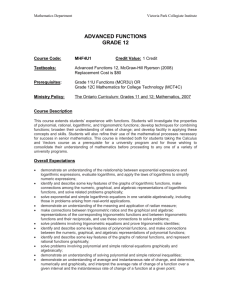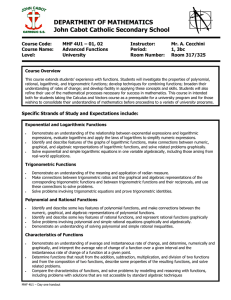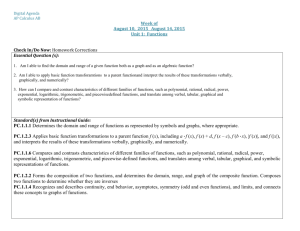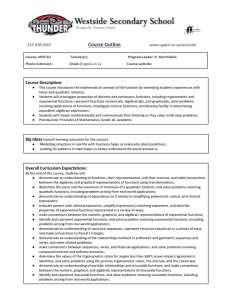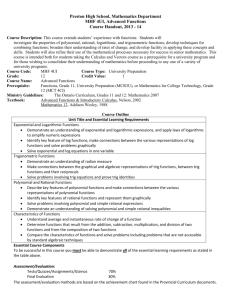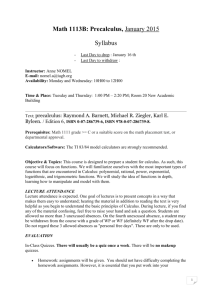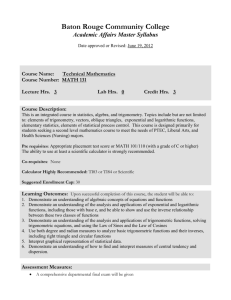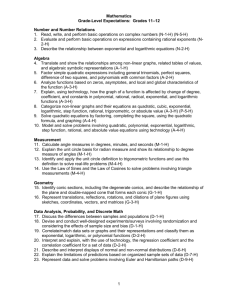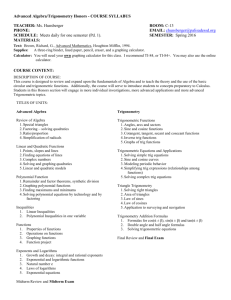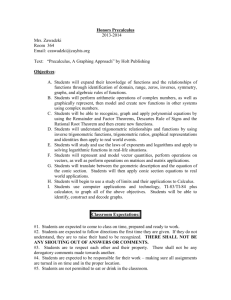Course Outline 519-938-9355 www.ugdsb.on.ca/westside
advertisement
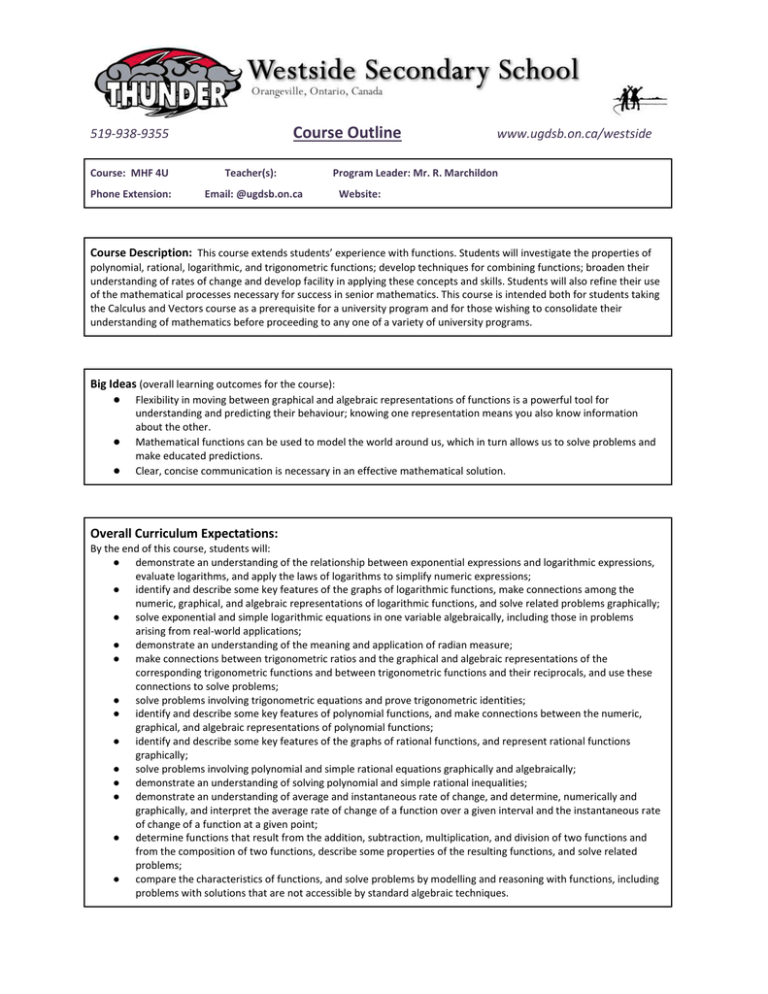
Course Outline 519-938-9355 Course: MHF 4U Teacher(s): Phone Extension: Email: @ugdsb.on.ca www.ugdsb.on.ca/westside Program Leader: Mr. R. Marchildon Website: Course Description: This course extends students’ experience with functions. Students will investigate the properties of polynomial, rational, logarithmic, and trigonometric functions; develop techniques for combining functions; broaden their understanding of rates of change and develop facility in applying these concepts and skills. Students will also refine their use of the mathematical processes necessary for success in senior mathematics. This course is intended both for students taking the Calculus and Vectors course as a prerequisite for a university program and for those wishing to consolidate their understanding of mathematics before proceeding to any one of a variety of university programs. Big Ideas (overall learning outcomes for the course): ● Flexibility in moving between graphical and algebraic representations of functions is a powerful tool for ● ● understanding and predicting their behaviour; knowing one representation means you also know information about the other. Mathematical functions can be used to model the world around us, which in turn allows us to solve problems and make educated predictions. Clear, concise communication is necessary in an effective mathematical solution. Overall Curriculum Expectations: By the end of this course, students will: ● demonstrate an understanding of the relationship between exponential expressions and logarithmic expressions, evaluate logarithms, and apply the laws of logarithms to simplify numeric expressions; ● identify and describe some key features of the graphs of logarithmic functions, make connections among the numeric, graphical, and algebraic representations of logarithmic functions, and solve related problems graphically; ● solve exponential and simple logarithmic equations in one variable algebraically, including those in problems arising from real-world applications; ● demonstrate an understanding of the meaning and application of radian measure; ● make connections between trigonometric ratios and the graphical and algebraic representations of the corresponding trigonometric functions and between trigonometric functions and their reciprocals, and use these connections to solve problems; ● solve problems involving trigonometric equations and prove trigonometric identities; ● identify and describe some key features of polynomial functions, and make connections between the numeric, graphical, and algebraic representations of polynomial functions; ● identify and describe some key features of the graphs of rational functions, and represent rational functions graphically; ● solve problems involving polynomial and simple rational equations graphically and algebraically; ● demonstrate an understanding of solving polynomial and simple rational inequalities; ● demonstrate an understanding of average and instantaneous rate of change, and determine, numerically and graphically, and interpret the average rate of change of a function over a given interval and the instantaneous rate of change of a function at a given point; ● determine functions that result from the addition, subtraction, multiplication, and division of two functions and from the composition of two functions, describe some properties of the resulting functions, and solve related problems; ● compare the characteristics of functions, and solve problems by modelling and reasoning with functions, including problems with solutions that are not accessible by standard algebraic techniques. Instructional Strategies: Westside teaching staff will use a variety of instructional strategies to help students develop and improve skills in the following areas: character, citizenship, communication, critical thinking and problem solving, collaboration and teamwork, and creativity and imagination. Assessment and Evaluation: Formative assessments are used to improve student learning by providing varied opportunities to demonstrate an understanding of course expectations in preparation for summative evaluations. Summative evaluations test groups of key expectations. Failure to complete a summative evaluation may result in the expectations of the course not being met and the credit not being granted. The following soft skills will be assessed: Responsibility, Organization, Independent Work, Collaboration, Initiative, Self-Regulation Late Policy Students are expected to complete all assigned work and submit it by the teacher's established due date. Every attempt will be made to encourage students to complete all assigned work on time so their grade represents their actual achievement. Should a student submit work past the due date, a late mark penalty will be assigned. All summative assessments must be submitted for course credit. Please see Westside's Assessment and Evaluation Policy for more details. Achievement Categories: Student learning is assessed and evaluated with respect to the following four categories of knowledge and skills. Knowledge and Understanding: 25% Thinking: 25% Communication: 25% Application: 25% Term Work (70%) Unit of Study Summative Evaluations Characteristics and Properties of Functions Understanding Rates of Change Paper & Pencil Test Polynomial Functions Polynomial Equations and Inequalities Paper & Pencil Test & Assessment Task Rational Functions, Equations and Inequalities Paper & Pencil Test & Assessment Task Trigonometric Functions Trigonometric Identities and Equations Day 1: Paper & Pencil Test (no identity proofs) Day 2: Identity Proofs Paper & Pencil Test Exponential and Logarithmic Functions Paper & Pencil Test Combinations of Functions part of final summative Final Summative (30%) Graphing Exam (paper and pencil) completed in-class during the final week (10%) Final Exam (paper and pencil) completed during exam period (20%) Course Materials and Replacement Cost Textbook: Advanced Functions (Nelson) Cost: $90 Student Expectations Every student enrolled in Mathematics at Westside is expected to: ● be prepared for class each and every day. This means you bring a writing utensil, calculator and paper with you to class ● actively participate in class discussions ● be on time to class ● complete homework assigned ● learn to problem solve using the techniques you will learn in class Final Assessments/Examinations Culminating activities for each unit must be completed by the student in order to achieve the credit. Failure to complete any one of them may result in loss of credit. There are no extensions or exemptions for final assessments without the approval from an administrator. ---------------------------------------------------------------------------------------I have read and understand the Course Outline: (all 3 pages) Student Name (please print): ______________________________ Signature: _____________________________ Parent/Guardian Name (please print): _______________________ Signature: _____________________________ Parent/Guardian email (please print): ______________________________________________________________
